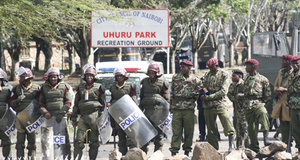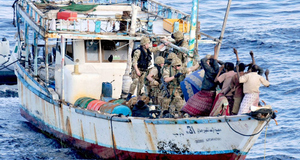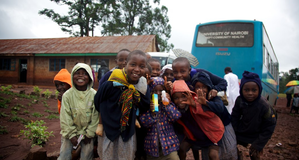Featured Article:Somali Refugees in Kenya: Security Deficiencies and Public Health Concerns as a Result of Ineffective Policy
By
2011, Vol. 3 No. 08 | pg. 2/2 | « UNHCR estimates that there is one health center in Dadaab for every 17,000 refugees – a number that is far below the minimum international standards (HRW 2009). There is only one full time NGO in Dadaab that focuses solely on medical care. Several other organizations, such as Doctors Without Borders, will occasionally send teams to Dadaab. However, for the most part, there is not enough funding or medical resources to effectively solve the health crisis. The U.S. Government began an initiative in 2010, working in conjunction with UNHCR and KEMRI [Kenya Medical Research Institute], to improve healthcare among refugees in Dadaab. A highly functioning laboratory was built at the camp’s main hospital in Dadaab, drastically lowering the amount of time it would take to obtain medical test results. Prior to this endeavor, test results would be driven to Nairobi, causing extensive time delays and leaving many of the samples in a deteriorated state. This new lab currently serves roughly 1,000 people each month and works to track possible public health problems and disease outbreaks (Global Health Initiative 2011). Many of the problems facing Dadaab are similar to those in the Kakuma refugee camp. It is important to note that unlike in Dadaab, Somalis in Kakuma only make up roughly 20% of the total refugees in the camp (Shultz 2009); however, that percentage is increasing. The Kakuma camp was set up in 1991 in northwestern Kenya originally to house a large group of Sudanese refugees. This camp was created by UNHCR, which worked with several NGOs to construct facilities. While Sudanese refugees [and several other ethnic groups] still live in designated areas of the camp, the population of Somalis has become an overpowering minority. This mass migration of Somalis began after the Mombasa refugee camps closed in 1997 and continues to this day, due to the intense overcrowding in Dadaab (Verdirame 1999). Most recently, a UNHCR initiative that began in 2009 transferred over 12,000 Somalis from Dadaab to Kakuma in an attempt to alleviate some of the overcrowding in the former (UNHCR 2009). Problems related to health care and security are continuously evolving and have created a difficult environment for both the refugees and the aid workers. In terms of disease, Kakuma has experienced numerous outbreaks and maintains a very high rate of malaria. A recent study coordinated by the Kenya Ministry of Health found that the weather conditions in the northwest of Kenya are conducive to high mosquito prevalence. Furthermore, the many water puddles within the region increase mosquito breeding. Thus, given the lack of prophylaxis and accessable health care, refugees in Kakuma face a huge problem with malaria (Bayoh et al. 2011). Cholera has also plagued Kakuma with several outbreaks, one of the most severe occurring in 2005. An epidemiological study conduced by the Kenya Ministry of Health and the U.S. Centers for Disease Control found several shocking conditions that contributed significantly to the spread of cholera and other diseases. For one, the drinking water for refugees is extracted from the ground and, although chlorinated, is prone to failure given the number of leaks in the system. Also, there are far too few latrines inside the camp, with recent estimates showing one for every thirteen refugees. Thus, A sub par sanitation system and limited potable water make Kakuma very susceptible to public health problems such as the 2005 outbreak, where 522 refugees became ill in a three-month time span (Shultz et al. 2009). Crime and SecurityOne of the devastating problems facing Dadaab and Kakuma is crime within the camps. Since the camps are, in essence, cities, it is not farfetched that some forms of crime exist within the borders. However, the desperation felt by many Somalis within refugee camps mixed with already existing clan and sub-clan disparities exacerbates criminal behavior and makes for widespread insecurity both inside and outside the facilities. UNHCR and other NGO staff are not allowed to move freely during the night hours due to the dangers within the camps and the possibility of crime directed towards aid workers. This, of course, creates a lawless society at nighttime, during which most crime takes place. Domestic violence, including physical and sexual abuse, is a common occurrence within the camps. The instances of domestic violence are unfortunately “accepted as normal by the majority of Somali refugees” and rarely reported to authorities (UNHCR 1999).Sexual violence and rape in Dadaab and Kakuma have gained increased international attention following a recent report by Human Rights Watch but have maintained notoriety within the camps since shortly after both opened. Some argue that rapes are severely underreported while others argue that due to the tremendous resources given to rape victims by NGOs, the instances of rape have been increasingly over reported. Nevertheless, the Human Rights Watch report made it clear that the most common circumstances for rape are based on inter-clan fighting – a concept that is not new to Somalis. Rapes are frequently inter-clan, meaning they are used as a scare tactic or punishment from one Somali clan to another (Crisp 2000). Unfortunately for the victims, there is rarely a formal solution and it is nearly impossible for a victim to take appropriate action. The reasons for this are twofold: First, Somali culture is male dominated and it is very difficult for a female Somali to speak openly. If a female were to openly accuse a male of a crime, it would likely cause further rifts within the community and she would, in all likelihood, not even be taken seriously. Second, the legal system within the camps is largely ineffective and powerless. Somali refugees enter Kenya from a country that has no formal legal system. Most punishments in Somalia occur by clan elders without any involvement by the government. The concept of blood money [referred to as mashallah] is a crucial part of the Somali justice system. Instead of courts, police and imprisonment, Somalis who commit offenses are allowed to [unofficially] buy their way out of trouble (Crisp 2000). This practice has occurred for hundreds of years within Somalia and is accepted, nearly unconditionally, by all Somalis. Of course, entering a refugee camp in Kenya that is overwhelmingly Somali means that the legal system will largely shadow that of Somalia. Theoretically, a refugee camp within the borders of Kenya must follow the laws and customs of Kenya. In practice, however, refugees establish informal justice systems, largely based on Islamic law (Verdirame 1999). If mashallah is not used to settle a criminal matter, a victim can attempt to notify UNHCR of the offense and in turn, the case can be sent from UNHCR to the Kenyan police. This, however, rarely happens and even when the police are involved, the outcome may not be positive. The police officers that are stationed in Dadaab and Kakuma are meant to keep refugees safe while, first and foremost, keeping Kenya safe. Road checkpoints are setup near the camps and vehicles traveling outside of the camps are frequently stopped and solicited for bribes. The security situations and terrestrial remoteness surrounding both camps give police officers leeway in dealing with Somali refugees. Refugees spotted outside the camp are technically in violation of the law and therefore, dealt with at the discretion of police officers (Nyaoro 2010). A Kenyan police officer’s notoriously low salary creates a strong incentive to handle the situations unlawfully and unethically. This means that substantial bribes are collected by police officers, including money and anything valuable. These instances are occasionally reported to authorities but unfortunately, the Kenya government is rarely willing to trust a Somali refugee over a police officer. ConclusionAs a way to alleviate some of the refugee overcrowding in Kenya, plans were created in 2009 by the UNHCR, USAID, and several other NGOs, to establish a fourth camp in Dadaab, named “Ifo II”. This camp was designed to hold 80,000 refugees and would immediately implement a strategy, known as the Security Partnership Project, helping to reduce many problems in refugee camps. This includes more efficient registration of new arrivals so that all refugees can be tracked and accounted for. In addition, a new police unit would be utilized solely within the camp as a form of protection and incident response. One of the key goals of Ifo II is to medically screen all new refugees before entering the camp so that public health risks can be partially mitigated (UNHCR 2010). As of 2011, the construction of the camp is complete but the Government of Kenya decided to stall the opening, due to pressure from the local community. Many citizens of Kenya [specifically those living in the North East Province] are angry that the conditions of this new camp exceed the living standards for most Kenyans (HRW 2011). While these are surely legitimate concerns for a citizen of Kenya to hold, it is dangerous for it to occur at the expense of eighty thousand refugees. With the construction completed and both the funding and plans to begin building an even newer Ifo III, the decision is up to the GOK to allow the process to proceed. Even with new camps being built, it would be a nearly impossible task to fully solve the refugee crisis. Thousands of Somalis continue to enter into Kenya every month and, while the Kenyan Government would rather not get involved, it is obligated to allow every refugee to enter. This obligation is surely a major burden on the government and the Kenyan people; however, it is a necessity to international humanitarian law. The most difficult task is finding a feasible balance whereby Kenyans can feel safe and refugees can be given aid. There are no indications that Somalis will stop entering Kenya and, as the last several decades have shown, neglecting refugees [whether in Eastleigh or in a camp] will not make the problem disappear. The fact remains that, in the words of a UNHCR official in Kenya, “you cannot create an island of security in a sea of insecurity” (Crisp 2000). Instead, the government must work closely with the UNHCR and other nongovernmental organizations to, at the very least, improve living conditions among refugees from one year to the next. ReferencesBayoh, Nabie M.; Akhwale, Willis; Ombok, Maurice; et al. 2011. "Malaria in Kakuma refugee camp, Turkana, Kenya." Malaria Journal 10:38. Campbell, Elizabeth H. 2006. "Urban Refugees in Nairobi: Problems of Protection, Mechanisms of Survival, and Possibilities for Integration." Journal of Refugee Studies 19:396-413. Crisp, Jeff. 200. "A State of Insecurity: The Political Economy of Violence in Kenya's Refugee Camps." Journal of African Affairs 99:601-632. De Montclos, Marc-Antoine Perouse; Kagwanja, Peter Mwangi. 2000. "Refugee Camps or Cities? The Socio-economic Dynamics of the Dadaab and Kakuma Camps in Northern Kenya." Journal of Refugee Studies 13:205-222. Genzuk, Michael. 2003. “A Synthesis of Ethnographic Research.” Center for Multilingual, Multicultural. University of Southern California, Los Angeles. Horst, Cindy. 2001. "Vital Links in Social Security: Somali Refugees in the Dadaab Camps, Kenya." University of Amsterdam, Netherlands. Human Rights Watch. 2011, "Kenya: Stop Deporting Somalis Fleeing Conflict" news, Retrieved June 4, 2011, (http://www.hrw.org/en/news/2011/03/31/kenya-stop-deporting-somalis fleeing-conflict). Kron, Josh. 2010. "Somalia's Wars Swell Refugee Camp." Pp. A6 in The New York Times. New York. Printed November 12, 2010. Lindley, Anna. 2007. "Protracted Displacement and Remittances: The View From Eastleigh, Nairobi." University of Oxford, Oxford, UK. Murunga, Godwin Rapando. 2005. "Conflict in Somalia and Crime in Kenya: Understanding the Trans- Territoriality of Crime." African and Asian Studies 4:138-160. Nyaoro, Dulo. 2010. "Policing with prejudice: how policing exacerbates poverty among urban refugees." The International Journal of Human Rights 14:126-145. Personal Communication. 2011. "Conversation Between Author and Unnamed Kenyan Source." Mombasa, Kenya. 19 May 2011. Shultz, Alvin; Omollo, Jared; Burke, Heather; et al. 2009. "Cholera Outbreak in Kenyan Refugee Camp: Risk Factors for Illness and Importance of Sanitation." The American Society of Tropical Medicine and Hygiene 80:640-645. U.S. Global Health Initiative. 2011, "Improving Health for Kenya's Refugees by Building Laboratory Capacity", Retrieved June 4, 2011, (http://www.ghi.gov/newsroom/stories/kenya/157632.htm). United Nations High Commissioner for Refugees. 2010. "Supplementary Requirements for Extension of Ifo Camp in Dadaab, Kenya and Protection Enhancement 2010." UNHCR. United Nations Statistics Division. 2010, "Social Indicators of Somalia", Retrieved May 4, 2011, (http://unstats.un.org/unsd/demographic/products/socind/population.htm). Verdirame, Guglielmo. 1998. "Human Rights and Refugees: The Case of Kenya." Journal of Refugee Studies 12:54-77.
Appendix 1
Informal interviews were conducted with the following subjects [in chronological order]:
Questions that were asked (Note: questions were varied based on the interview subject):
Suggested Reading from Inquiries Journal
Inquiries Journal provides undergraduate and graduate students around the world a platform for the wide dissemination of academic work over a range of core disciplines. Representing the work of students from hundreds of institutions around the globe, Inquiries Journal's large database of academic articles is completely free. Learn more | Blog | Submit Latest in International Affairs |


















